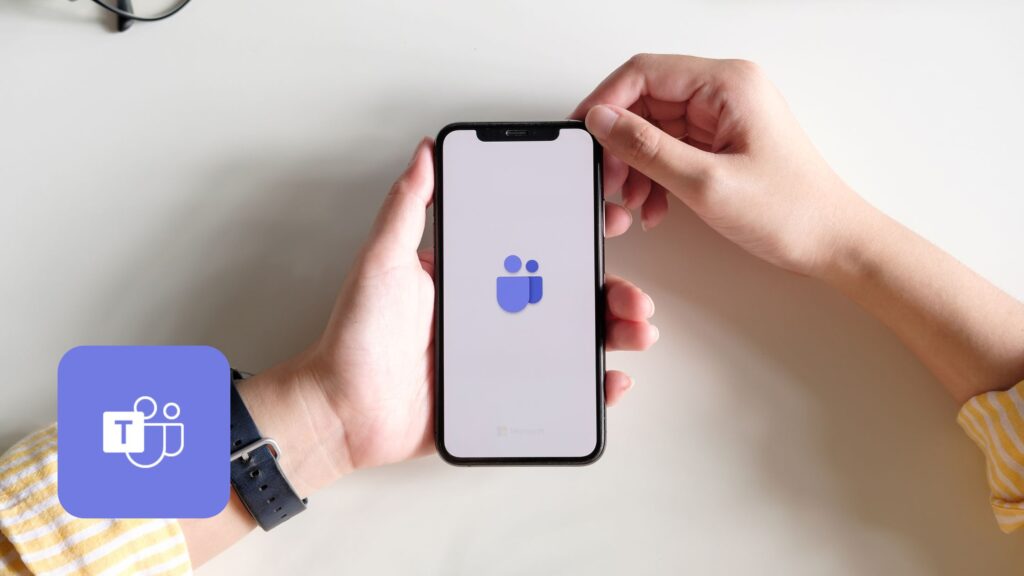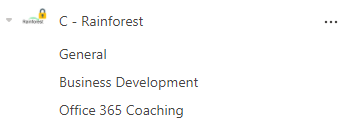
All the project management tools you need can be found in Microsoft Teams. At Regroove, our project management starts in and flows from the Teams app. It’s where we spend most of our day, communicate with our team members and clients, share files and resources, and create and manage tasks.
Whether the project is for a client or an internal initiative, the process is much the same. In this blog, we’ll walk through the steps our project managers take to set up and use Microsoft Teams for project management on a client project.
Creating the Team
When a client moves from the sales process into project kickoff, they’re assigned a project manager (PM). The PM typically meets with the sales team to ensure information gathered throughout the presales process is passed on, and to determine who will be a part of the project team.
Once the project team has been assembled, the project manager fills out our automated Microsoft Teams creation form.

This automated Microsoft Form sends a team creation approval request to a dedicated group of approvers at Regroove. Approvers can approve or deny the request with the click of a button.
For every client, we create two Teams – an internal and an external. The internal Team consists of the account manager, project manager, delivery team, and account administrator. We always preface the internal Team with “C -”, followed by the client name (for example, C – Rainforest). The “C” at the beginning of the Team name is a quick and easy way to ensure we know the audience included in the Team; in this case, the audience only includes Regroove staff.

The external Team includes all the internal staff involved in the project, as well as key client team members who we work directly with throughout the project’s lifespan. This might include business analysts, business champions, members of the client’s technical team, and project stakeholders. Our external Team always begins with “EXT -”, followed by the client’s name (for example, EXT – Rainforest) so we can tell at a glance that the team includes external guests.

The separation of internal and external audiences means we have a space to communicate internally. We can have technical discussions, provide options and feedback, ask for advice, and discuss resourcing. The external Team provides a place to hold out loud conversations with the client, where we can ask business process questions, collect feedback, make and post about decisions, and discuss testing and implementation.
Teams Creation Tips
- Automate or govern the Team creation process (Teams should not be created without permission and a clear purpose).
- Create a Team for each audience (internal and external) where applicable.
- Develop naming conventions that clearly include the Team’s purpose and audience.
Setting up Team Channels
When the Teams are ready to go, we create the appropriate channels. Both Teams will have identical channels to ensure consistency and prevent confusion about where topics should be discussed. Every Team is automatically generated with a General and Business Development channel:
- General – Every Team gets a general channel automatically. We recommend keeping the general channel free of conversation, as it maintains a record of members that were added and removed from the team, as well as channels that have been created or deleted. It acts as an easy reference point for the project manager to see activities that have occurred in the management of the Team.
- Business Development – A business development channel is automatically generated by nature of our automated process; this is not a Microsoft standard. The purpose of this channel is to host discussions not related to an ongoing project, which may include invoice and billing questions, discussions about future project work, or requests for support not related to the current project scope.
We also include a channel named for the client’s project. We host all our project-related discussions in this channel, organized into conversation threads with subject lines to make it easy to find and jump back into a past conversation. If we have multiple ongoing projects with a client, we create a new channel for each project.
Team channel tips:
- Leave the General channel clear of conversation for quick review of member and channel additions and removals.
- Create a space (like “Business Development” or “Water Cooler”) where teams can hold non-project related conversations.
- Create a channel for each client project.
- Post a description of the channel’s purpose in each channel.
- Ensure your channels are the same in both the internal and external teams.
Communicating in Teams
When the Teams and their channels are ready and the internal and external project team has been invited, we move into the planning phase of the project lifecycle. This begins with internal and external kickoff meetings. The internal kickoff meeting acts as a knowledge transfer between the project manager and the project delivery team to ensure they have a baseline understanding of the client’s requirements. The external kickoff meeting is a chance for the client to meet the project manager and delivery team, to outline project and communication expectations, and to agree on next steps as the project gets underway.
At this stage of the project, the project manager works to ensure good communication is fostered between the client and the project team. We start by ensuring the client understands how to effectively communicate in Teams. In the external Team, the project manager posts a description of each channel that helps focus conversation in the appropriate place. They also include instructions for the client with best practices on communicating in teams. This includes:
- Starting a new conversation.
- Replying to a conversation thread.
- Reacting to a message.
- Editing and deleting messages.
- @ mentioning team members.
Ensuring the client has a basic understanding of the common Teams communication practices helps strengthen communication on the project from the start.

We also host all our project meetings in Microsoft Teams. Meeting dates are determined either through discussion in the external team, or with a handy tool called Find Time that allows invitees to vote on dates and times that work best with their schedule. Once the meeting is scheduled, the project manager will draft an agenda and record the meeting for those who are not able to attend. In the internal team, we often make use of the ‘Meet Now’ feature, which allows project team members to take a channel conversation into a meeting for further discussion, clarification, or to make an agreed upon decision.
Communication is the most important ingredient to our project successes. We work diligently to ensure the client is kept informed of any steps we take, decisions that need to be made, and relevant outcomes. Microsoft Teams is key for ensuring that these conversations are held out loud in view of the entire project team to increase transparency and efficiency.
Communicating in Teams tips:
- Ensure internal and external team members understand the purpose of each channel.
- Post tips for basic communication in Teams.
- Offer optional Teams communication coaching to your clients.
- Stress the importance of out loud communication from project kickoff onwards.
Task Management
As the project kicks off, the official scope of work is attached to the project channel as a channel tab so that it can be easily referenced throughout the project timeline.

Channel tabs sit at the top of the Teams channel and are accessible to every member of the team. We might also include project timelines in Excel or Project Online, links to relevant websites, the OneNote where meeting agendas, minutes, and detailed project notes are kept, and any other app or website directly related to the management of the client’s project.

Everything we need to track and manage tasks related to a project is available in Microsoft Teams. We use Microsoft Planner for task management, which can be linked to the team as a channel tab. In Planner, the project manager creates tasks, adds details including steps, due dates, and related tasks, and assigns them to members of the project team. We organize the planner into the categories that align with our scope of work for easy tracking against the remaining budget. The project manager can quickly gain an understanding of outstanding project tasks and their progress by reviewing the project planner board.
Planner tasks appear in everyone’s Microsoft To Do app, where team members can see tasks assigned to them across multiple projects and add their own to do items. Team members plan their day by selecting which tasks they will work on each morning. Completing a task within Microsoft To Do automatically updates the task in the project planner.
Microsoft Planner tips:
- Make a new Microsoft Planner for every project and link it to the team as a channel tab
- Create categories or ‘buckets’ to sort your tasks that match your project organization
- Create tasks with as much detail as possible, including steps, due dates, and related tasks
- Assign tasks to team members
Monitoring
Throughout the project lifecycle, much of the role of the project manager is monitoring the budget, scope, and outstanding tasks for the project team. Where possible, we set up automations that ensure communication is directed back to the Microsoft Team for out loud discussions. This might include support request forms with responses sending back to the project channel, automated updates from the client’s technical systems, or other forms and automations that help monitor the client’s project health.
Monitoring tips:
- Use Microsoft Forms or other survey applications to collect feedback and support requests from the client team and funnel them into the appropriate project channel for out loud discussion
Project Closure
When the project is completed and the deliverables have been met, we provide the client with a summary document that outlines the project team, the work provided, and how to care for their cloud solution in the future. Rather than archiving or deleting the team, we leave it open as a line of communication with the client should they need support, coaching, or additional projects in the future. Our client relationships often develop into long term partnerships. We’ll create and retire project channels as our work with the client evolves, but the team will remain constant as an option for communication with the client team.
Project closure tips:
- Give your client a tangible document to keep that outlines the work performed, required maintenance, and your contact information for future projects
- Leave the Team open as a line of communication with the client
Conclusion
While Microsoft Teams isn’t known as “the hub for project management”, we certainly think of it that way at Regroove. Microsoft Teams is a logical place to tie all the necessities of managing a technical project together – communication, documentation, task management, and access to important information, tools, and resources. We believe that good communication is the key to a successful project, and Microsoft Teams helps us ensure open, out-loud communication between the project delivery team and the client stakeholders from day one. The other building blocks of project management can easily be tied back to the team, making it the central hub for each project.
Want to set your Microsoft Teams up for project management success? Get in touch! We can help.